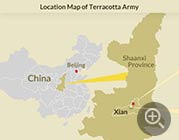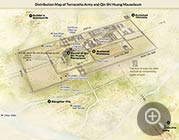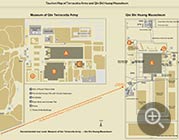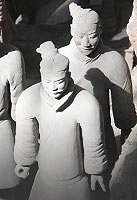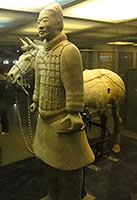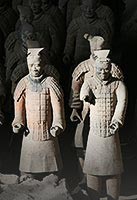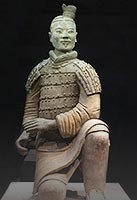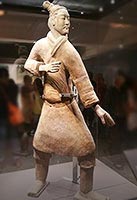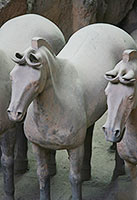Terracotta Army
Being the most significant archeological excavations of the 20th century and a UNESCO World Heritage Site, the Terracotta Army is no doubt a must-see for every visitor to Xi'an.
Originally the ancient funerary project for Emperor Qin Shi Huang, the Terracotta Warriors China are now displayed in a live museum built on the site, officially named Emperor Qinshihuang's Mausoleum Site Museum, showing the life stories of the emperor and the once powerful Qin Empire (221 – 207BC) in those days of pomp and vigor.
Terracotta Army Facts
![]() 10 Amazing Facts You didn't Know
10 Amazing Facts You didn't Know
![]() Where are the Terracotta Warriors Located?
Where are the Terracotta Warriors Located?
![]() History – over 2,200 years
History – over 2,200 years
![]() When was the Terracotta Army Built?
When was the Terracotta Army Built?
![]() Chronicle – 246 BC to today
Chronicle – 246 BC to today
![]() Discovery – by local farmers, in 1974
Discovery – by local farmers, in 1974
![]() Who found the Terracotta Warriors?
Who found the Terracotta Warriors?
![]() What is the Terracotta Army? 10 Things You should Know
What is the Terracotta Army? 10 Things You should Know
![]() Why are the Terracotta Warriors Important?
Why are the Terracotta Warriors Important?
![]() Who Built the Terracotta Warriors?
Who Built the Terracotta Warriors?
![]() Why was the Terracotta Army built?
Why was the Terracotta Army built?
![]() How many Terracotta Warriors are there in China?
How many Terracotta Warriors are there in China?
![]() How the Terracotta Warriors were Made
How the Terracotta Warriors were Made
![]() How to Repair the Damaged Terracotta Statues
How to Repair the Damaged Terracotta Statues
![]() How to Protect the Terracotta Warriors
How to Protect the Terracotta Warriors
![]() A Little-known Case of Terracotta Warriors Theft in 1987
A Little-known Case of Terracotta Warriors Theft in 1987
![]() World Leaders & Celebrities Who Have Visited the Terracotta Army
World Leaders & Celebrities Who Have Visited the Terracotta Army
![]() Let's Smash the 5 Rumors of the Terracotta Army
Let's Smash the 5 Rumors of the Terracotta Army
![]() Who's the Real Owner of the Terracotta Army?
Who's the Real Owner of the Terracotta Army?
![]() Were the Terracotta Warriors Made of Real Human Beings?
Were the Terracotta Warriors Made of Real Human Beings?
Terracotta Army Visitor Guide
What to See
1. Museum of Qin Terracotta Warriors and Horses
![]() Insider's Suggestion:
Insider's Suggestion: ![]()
![]()
![]() MUST-SEE, 2 to 4 hours
MUST-SEE, 2 to 4 hours
It contains 3 major pits tagged in the order of their discoveries and the Bronze Chariots and Horses Exhibition Hall.
![]() Pit 1: the largest; found in 1974 and opened to the public on Oct. 1st, 1979. There is the vanguard in three rows followed by a massive battle array of infantry and war chariots.
Pit 1: the largest; found in 1974 and opened to the public on Oct. 1st, 1979. There is the vanguard in three rows followed by a massive battle array of infantry and war chariots.
![]() Pit 2: found in 1976; 20 meters northeast of No. 1 Pit. It is the most spectacular one for the variety of divisions including infantry, crossbow team, cavalry, and 80 chariots.
Pit 2: found in 1976; 20 meters northeast of No. 1 Pit. It is the most spectacular one for the variety of divisions including infantry, crossbow team, cavalry, and 80 chariots.
![]() Pit 3: found in 1996; 25 meters northwest of No. 1 Pit. It was the command post of the armed forces, with 68 warriors and a chariot led by four horses.
Pit 3: found in 1996; 25 meters northwest of No. 1 Pit. It was the command post of the armed forces, with 68 warriors and a chariot led by four horses.![]() There is also a Pit 4 between Pit 2 and Pit 3, but it has no terracotta sculptures or other relics inside except some backfilled soil, so not open to tourists.
There is also a Pit 4 between Pit 2 and Pit 3, but it has no terracotta sculptures or other relics inside except some backfilled soil, so not open to tourists.
2. Qin Shi Huang's Mausoleum Site Park (Lishan Garden)
![]() Insider's Suggestion:
Insider's Suggestion: ![]() extra 2 hours, for slow paced travelers, in-depth visit
extra 2 hours, for slow paced travelers, in-depth visit
centering on the burial mound of Qin Shi Huang Mausoleum, with several Accessory Pits around, including:
![]() Pit K0006 – Civil Official Figures
Pit K0006 – Civil Official Figures
![]() Pit K0007 – Bronze Aquatic Birds (not open yet)
Pit K0007 – Bronze Aquatic Birds (not open yet)
![]() Pit K9801 – Stone Armor and Helmets (not open yet)
Pit K9801 – Stone Armor and Helmets (not open yet)
![]() Pit K9901 – Acrobatics Figures
Pit K9901 – Acrobatics Figures
Currently, there are no direct public transport means to Terracotta Army from downtown Xi'an. Therefore, the best option is to join a Xi'an day tour involving this site with attracting service and price.
If you wish to travel independently, please follow the following instructions:
1. Take metro line 1 to Fangzhicheng, transfer to metro line 9 and get off at Qinling West Station. Then take the shuttle bus 617, which operates between 6:30 and 20:30 to the museum. Passengers can also get off at Huaqing Pool Station on metro line 9, and then take Lintong Bus 602 to the Terracotta Army.
2. Take metro line 1 to the terminal stop Fangzhicheng, then take the tourist bus 5 (306) from a roadside bus stop 25-30 meters north to the nearby Fangzhicheng Bus Station, which operate between 7:00 and 19:00, at the fare of CNY 5. It will take you to the Terracotta Warriors Museum.
3. A taxi from downtown Xi'an to the museum takes 40-50 minutes and costs about CNY 150.
How to get to Terracotta Warriors from Xi'an Airport
1. Take airport shuttle bus Lintong Line to Xi'an University Science and Technology in one hour, and then take Lintong Bus 602, or tourist bus line 5 (306) to the museum in 30 minutes.
2. Take airport metro line to Beikezhan (Xi'an North Railway Station), change to line 4 to Wulukou, then change to line 1 to Fangzhicheng, and last take metro line 9 to Huaqing Pool, where you can take Lintong Bus 602 to Terracotta Army.
3. A taxi from Xi'an Airport to Terracotta Army takes 70 minutes and costs about CNY 200.
How to get to Terracotta Warriors from Xi'an North Railway Station
1. Take metro line 2 to Beidajie, then change to line 1 to Fangzhicheng, next change to line 9 and get off at Huaqing Pool. Finally take Lintong Bus 602 to get there.
2. Taxi: 1 hour; about CNY 160.
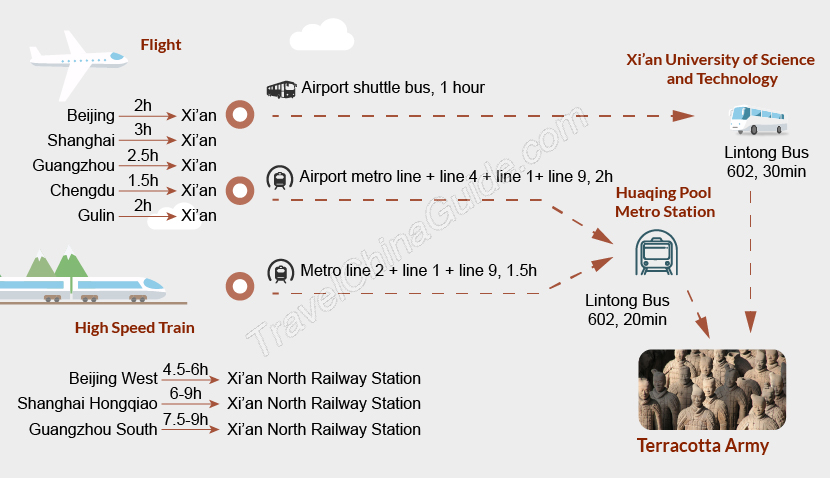 |
| Ticket Price | CNY 120; free for children under 1.4 m (4.6 ft) accompanied by a paying adult. |
| Audio Guide | Rent: CNY 40 per person; Deposit: CNY 100 |
| Opening Hours | March 16 to November 15: 8:30 - 18:00, ticketing stops at 17:00; November 16 to March 15: 8:30 - 17:30, ticketing stops at 16:30. |
| Time for a Visit | 3 hours |
Further Reading
About the Master of Terracotta Army China - Qin Shi Huang
Upon ascending the throne at the age of 13, Emperor Qin Shi Huang had begun to prepare for his mausoleum. Taking 11 years to finish, the mausoleum is speculated to house many treasures and sacrificial objects. The most amazing masterpiece should be the Terracotta soldiers guarding the emperor in his life after death.
Features of Statues
You May Like
 Reply
Reply 0
0 0
0 Reply
Reply Reply
Reply 0
0 0
0 Reply
Reply Reply
Reply 0
0 0
0 Reply
Reply Reply
Reply2) Are both in the same location?
 0
0 0
0 Reply
Reply Reply
Reply 0
0 0
0 Reply
ReplyAfter arriving, take tourist bus no.5 (306) to the destination.
